

Top 5 gamification examples from exciting fintech apps across the world
Top 5 gamification examples from exciting fintech apps across the world
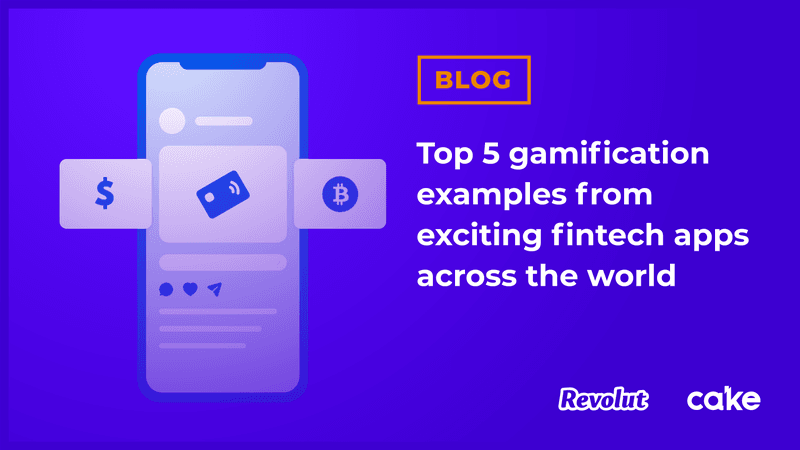
This article explores top gamification examples from successful fintech apps around the globe, providing insight into effective user engagement strategies.
Fintech is the hottest item in the banking industry and with good reason! Decreasing physical bank visits is a consistent trend amongst all age groups. And it’s not just payments, it’s everything. Fintech allows banks to improve the customer experience and streamline, digitize or disrupt financial services. But doing it right is another thing. In fact, 75% of venture-backed fintech startups fail within the first year. However, gamification is one of the best solutions to increase your chance of being the startup that succeeds.
In this article, we’ll be looking at some gamification examples from winning fintech apps, designed to boost customer motivation and engagement.
Let’s go!
- Why fintech apps use gamification and who is doing it best
- Cake personalizes cashback rewards (subtly incentivizing app engagement)
- Ikano bank gave one lucky user a $14,000 prize for winning a mini-game
- Monobank uses a badge reward system to foster customer motivation
- Revolut successfully targeted students with a leaderboard competition
- Fortune City builds a virtual world based on customer financial data
- Recap
Why fintech apps use gamification and who is doing it best
The case for gamification is clear: gamifying your app will boost brand equity and customer engagement. Ultimately, this helps your app stand out, and that has never been more important than now! Currently, the fintech industry is growing fast and investors are jumping at the opportunity to get involved. Just take one look at the creation rate of unicorns (companies valued over $1 billion) . Almost 40% of all fintech unicorns were made in the first 8 months of 2021. This includes companies based around the globe, from the US, to France, to Singapore.

This graph illustrates the explosive growth of fintech unicorns, highlighting the increasing competition in the market and the need for differentiation.
The wild growth in fintech has many external factors, ranging from the increase in mobile phone ownership to the rising penetration of digital platforms in our everyday lives. Given this, the need to distinguish your app from others is crucial.
As such, in user engagement strategies fintech apps are turning to a gamified system. Gamification is the use of game-like elements in non-game contexts. The game-like mechanics make the user experience more fun and satisfying. When done right, gamification strategies drive behavioral change and boosts customer motivation.
Common gamification examples include a badge reward system or features like progress bars. Today, gamification is surging in popularity. In numbers, the gamification market is set to rise from USD 15.43 billion in 2024, to over $48 billion by 2029!
Curious? Explore the science behind gamification's impact on behavior change here!
With this in mind, there is no shortage of exciting fintech gamification examples that boost customer motivation. These 5 apps, in particular, are super interesting:
- Cake. A Belgian startup from 2020 that shares its profits with users!
- Ikano bank. A Swedish bank that focuses on small savers.
- Monobank. Get this - 10% of all Ukrainians use this cat-themed neo-bank!
- Revolut. The UK’s most valuable fintech with over 16 million customers.
- Fortune City. A Taiwanese city-building app that organizes your finances!
In short, these companies are using gamification to make their apps exciting. Gone are apps where bookkeeping has to be a chore! So let’s see exactly how each app does it.
Cake personalizes cashback rewards (subtly incentivizing app engagement)
Cake is a fintech startup with over 120,000 users that pays people for insights into their financial behavior. Here’s how it works: Cake’s clever AI analyzes all of your transactions and then makes an informed and personalized choice about which cashback rewards are the best for you.
This personalized reward system makes the app more relevant for every user. Irrelevant cashback rewards do not create any customer value, and soon enough users will stop opening your app if they aren’t getting anything out of it. On the flip side, users are aware that the more they use the app, the more relevant their offers will be. This incentive program clearly nudges users to engage!
Personalized features are a cornerstone of gamification and the effects are clear. With push notifications, for instance, personalization boosts your conversion rate by 40%.
The reward system also acts as a form of instant feedback. This gamification example is a form of positive reinforcement that keeps the user coming back. Imagine buying printing supplies at a stationery shop using your card. Then, the next time that you check your app, there are deals from similar vendors.

The Cake app demonstrates this principle by delivering personalized cashback rewards, which creates a more relevant and engaging user experience.
Check out our gamification software to prevent customer churn on your fintech app today!
Ikano bank gave one lucky user a €10,000 prize for winning a game
In 2014, the Swedish bank Ikano ran a 3-week marketing campaign with the game ‘Flappy Saver’. In the game, players control a flying piggy bank and try to protect their savings by avoiding crashing into stores where you might spend your money. The game is based on Flappy Bird, which at the time was actually the most downloaded app on the App Store.
Gamification alone makes your customer voice more positive by incorporating elements like rewards, achievements, and progress tracking, consequently enhancing customer engagement and satisfaction.
Here’s the twist, however, this game promised a €10,000 prize to the highest scorer!
Cash prizes can also be highly effective on user engagement. Research shows that performance and output improve when a financial reward is present. The study notes, however, that the effect may be detrimental in the medium or long term. With that in mind, the Flappy Saver campaign was smart to be just 3 weeks long.
During those 21 days, the game saw over 1.5 million plays! Now that’s a lot of engagement, and it seems especially impressive when you learn that just under 10 million people live in Sweden.

Ikano Bank's 'Flappy Saver' campaign shows how a time-sensitive competition with a significant prize can drive massive user engagement and brand awareness.
Monobank uses a badge reward system to foster customer motivation
An incredible 1.3 million people use the Monobank app every day. Since 2017, the app gained over 6 million loyal customers, due to catering to the significantly high demand for neo-banks in Ukraine. So, one can assume, their app must be really good - and it is!
Monobank clearly knows how to motivate people. Their badge reward system is just one of many gamification examples used to drive behavioral change. Studies are clear that achievements improve customer motivation. On one hand, receiving a badge positively reinforces your desired user behavior. On the other hand, seeing locked badges motivates users to unlock them. This mechanic is called ‘constraint’. In other words, people don’t like missing out and will be motivated to unlock any greyed-out features.
Another unique feature of the app is Monobank’s signature cat mascot. The advantages of a mascot are many. For one, the cat differentiates the user experience from other apps, making the Monobank app special and memorable. In addition, research shows that a mascot contributes to brand trust and building customer rapport. Interesting to note, however, that the cat does not feature in Monobank’s UK project, Koto. Apparently, British market experts thought the cat’s expressions were ‘too cunning’ and would turn people off. It just goes to show how gamification works differently for various audiences.

Monobank's badge system is a perfect example of using achievements to positively reinforce user behavior and motivate continued app usage.
Revolut successfully targeted students with a leaderboard competition
When expanding to Europe, Revolut organized a competition between universities that encouraged students to register and boost their university to the top of the rankings. With a goal of targeting a younger demographic, the leaderboard featured communities, rather than individuals.
This gamification feature taps into the need for social relatedness. In brief, a shared goal makes people feel like they belong and research shows that the need to belong is an extremely fundamental and powerful motivator. By the end of the campaign over 100 universities and 1000s of students signed up!
Competitions are good fun and are excellent at harnessing intrinsic motivation. This is when your app is naturally fun and satisfying to use. You can enhance this effect even more with a prize, such as Revolut offering free premium accounts to the winners.
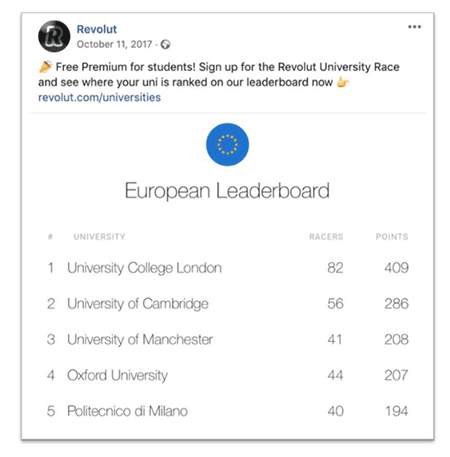
This leaderboard from Revolut's university challenge effectively utilizes social relatedness and competition to drive a high volume of sign-ups.
Fortune City builds a virtual world based on your financial data
Gamification can go from a few light touches to a near full-on game. For certain, Fortune City is the latter. While the app promotes itself as a way to ‘track your spending’, it also functions as a personalized city builder. If you spend regularly on transport tickets, for example, railways and bus stops will appear in your city. After that, virtual sims can use your transport system to get to jobs that you assign based on their skills. Finally, all of these tasks will earn you coins to compete against friends!
To be sure, this is super creative and excellent at fostering customer motivation. Not only does the city include personalization to people’s habits and interests, but the appearance of buildings also acts as instant feedback. It’s almost like a progress bar! Instead, this progress bar is a city, and that is super exciting. Of course, there are also detailed graphs and formula sheets to really dive into the data.
Fortune City is a highly creative piece of app development, and in 2018 was given an Android Excellence award by Google Play Store. It comes as no surprise that this app boasts 5 million users!
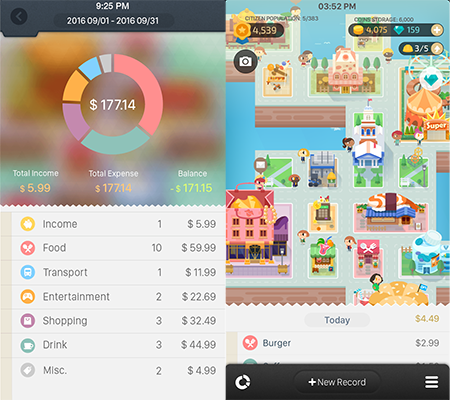
Fortune City's interface showcases a deeply creative gamified approach, transforming the chore of financial tracking into an engaging city-building game.

This banner serves as a call to action, demonstrating how visual prompts can guide users toward desired actions like booking a strategy session.
Recap
In the past year, almost 2000 new fintech startups set up shop in America alone. With 75% of those failing, winning apps have figured out something crucial to app success: engagement. Following the example of market leaders, they leverage gamification to drive customer motivation.
Why fintech apps use gamification and who is doing it best
Gamification boosts brand equity and engagement and that’s important! Fintech is growing faster than ever. In fact, almost 40% of all fintech unicorns were made in the first 8 months of 2021. This growth is affecting markets all across the globe.
To stand out, then, fintech is turning to gamification. Gamification is the use of game-like elements in a non-game context, often used to make the user experience more fun and satisfying. Here are 5 gamification examples from leading apps in the fintech industry:
#1 Cake. A Belgian startup from 2020 that shares its profits with users!
Cake’s clever AI analyzes all of your transactions and then personalizes your cashback rewards. Why is this so good? Because irrelevant offers do not create any customer value and will turn off your users. Also, users are aware that the more they use the app, the more relevant their offers will be. This is a clear nudge to increase engagement!
Personalized features are a cornerstone of gamification and the effects are clear. With push notifications, for instance, personalization boosts your conversion rate by 40%.
Prevent customer churn on your financial platform! Check out our software here.
#2 Ikano bank (and their 3-week campaign with a €10,000 prize).
In 2014, the Swedish bank Ikano ran a 3-week campaign with the game ‘Flappy Saver’. The game dynamics included players controlling a flying piggy bank and trying to protect their savings by avoiding crashing into stores where they might spend their money. In the end, the winning user would get €10,000. Across those 21 days, the game saw over 1.5 million plays!
To be sure, cash prizes can be highly effective. Research shows that performance and output improve when a financial reward is present.
#3 Monobank. Get this - 10% of all Ukrainians use this cat-themed neo-bank!
An incredible 1.3 million people use the Monobank app every day. Customer motivation is fostered through gamification examples like the badge reward system. The effects are twofold: receiving a badge gives users positive reinforcement, and seeing locked badges motivates users to unlock them. This mechanic is called constraint. In short, people don’t like being excluded and will be motivated to unlock any greyed-out features.
This is not to mention how each badge features Monobank’s signature cat mascot. The advantages of a mascot are many. For one, the cat differentiates the user experience from other apps, making the Monobank app special and memorable. In addition, research shows that a mascot contributes to brand trust and building customer rapport.
#4 Revolut. The UK’s most valuable fintech with over 16 million customers.
Revolut has plenty of gamification examples to learn from. When expanding to Europe, Revolut ran a leaderboard campaign that encouraged students to register and boost their university to the top of the rankings. As the leaderboard featured communities, rather than individuals, this feature taps into the need for social relatedness.
In brief, a shared goal makes people feel like they belong and research shows that the need to belong is an “extremely” fundamental and powerful motivator. This must-have worked for the over 100 universities and 1000 students who signed up!
#5 Fortune City. A Taiwanese city-building app that organizes your finances!
While the app promotes itself as a way to ‘track your spending’, it also functions as a personalized city builder. If you spend regularly on transport tickets, for example, railways and buses will appear in your city. Completing tasks will then earn you coins to compete against friends! To be sure, this is excellent at fostering customer motivation.
Not only is the city personalized to users’ habits, but the appearance of buildings is also a form of instant feedback and acts as a progress bar, showing users how much work they have put in! Today, 5 million people use Fortune City. For sure, one of the most creative gamification examples!
Ready to gamify ? Get a tailored-action plan in our gamification workshop!
Related Posts
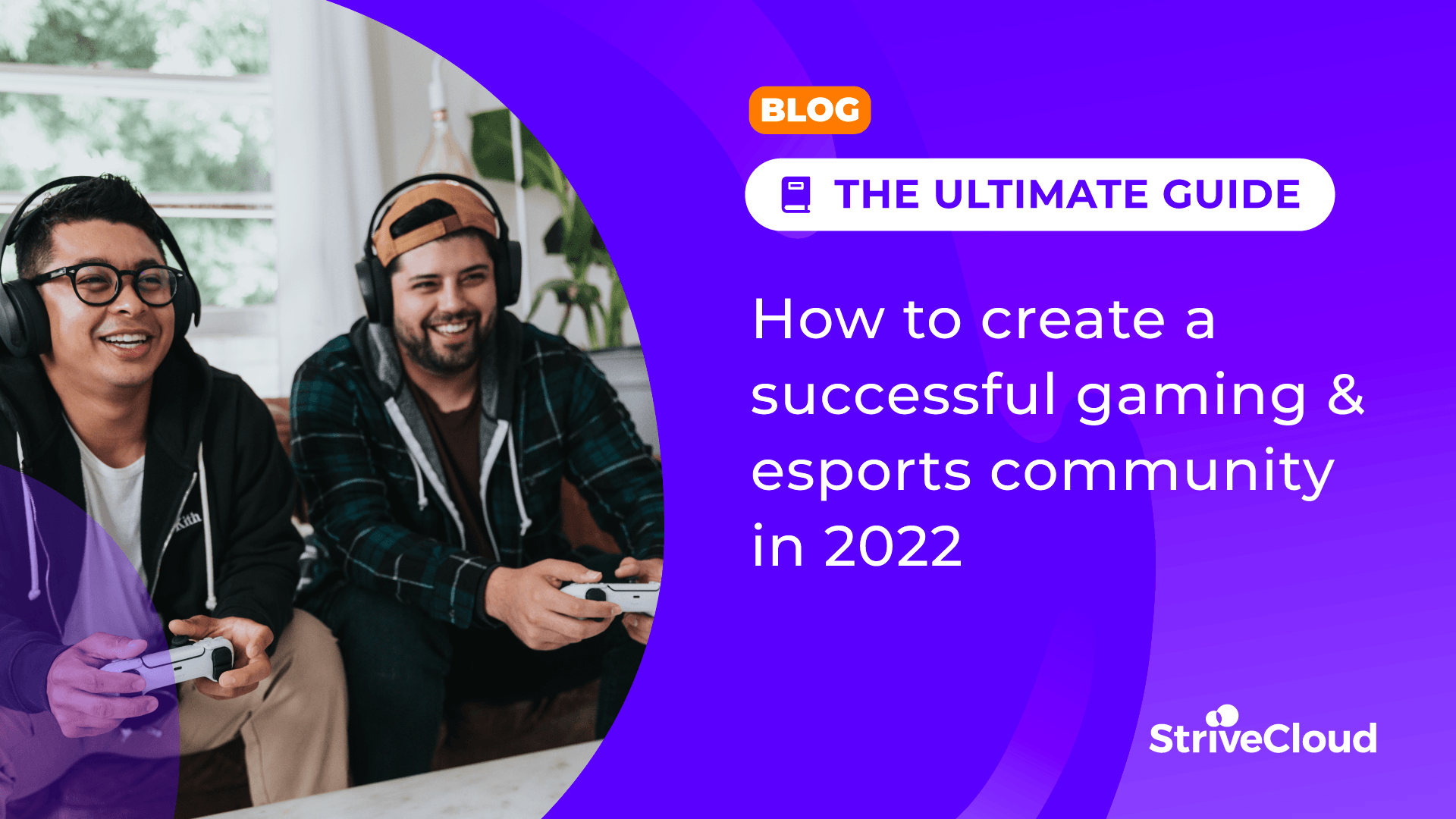
How to build a successful gaming and esports community in 2022: The definitive guide
Gaming and esports communities are rapidly growing among the seemingly “unreachable” target audience of digital natives. In this guide, we’ll show you everything you need to know to build, grow and monetize your own esports and gaming community.
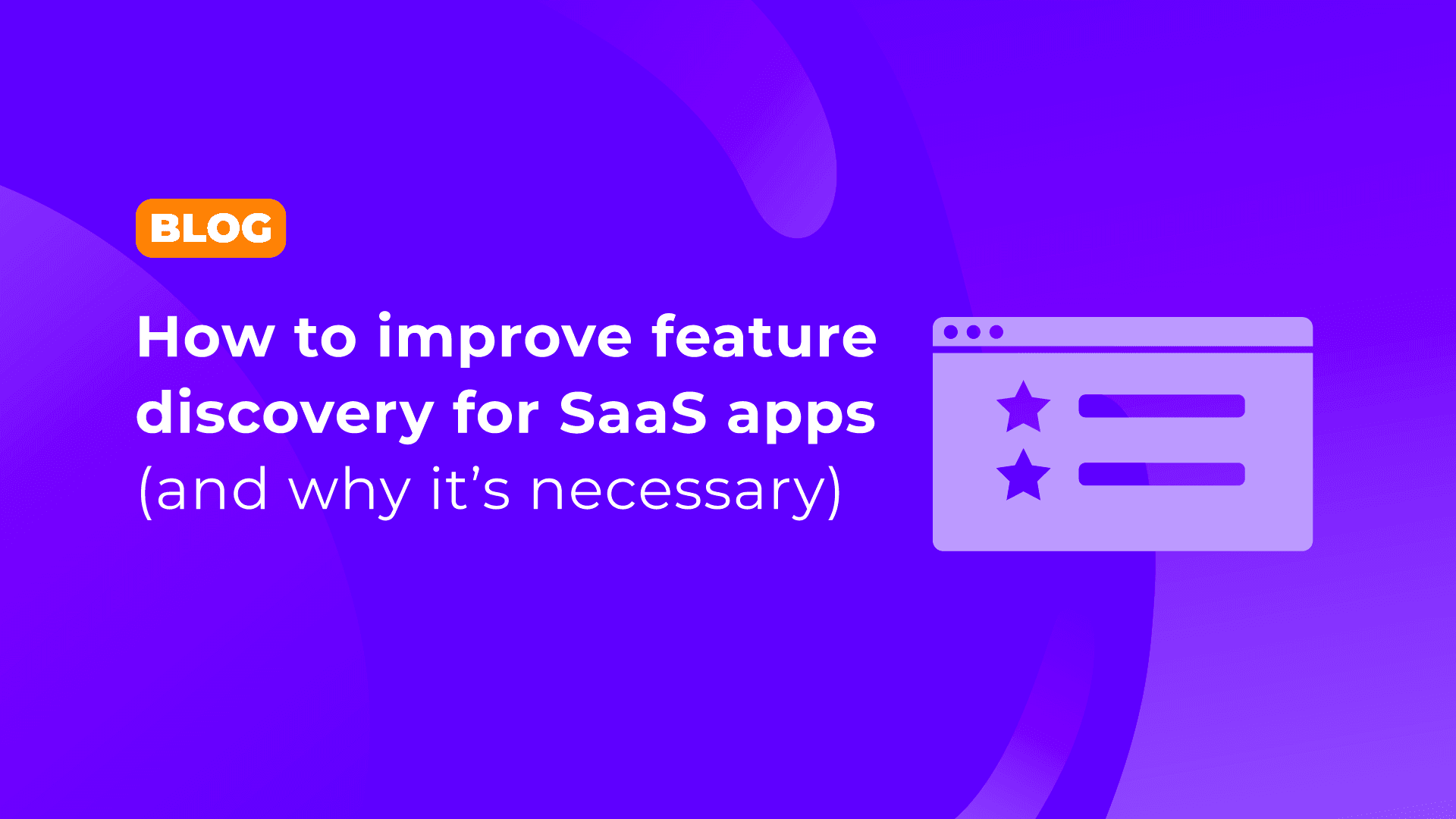
How to improve feature discovery for SaaS apps (and why it’s necessary)
In reality, 12% of a product’s features attract the majority of user engagement. That leaves plenty of room for improvement. Feature discovery is a great way to spread awareness & educate users on your product. As the perceived value of your product rises, so do retention rates!

